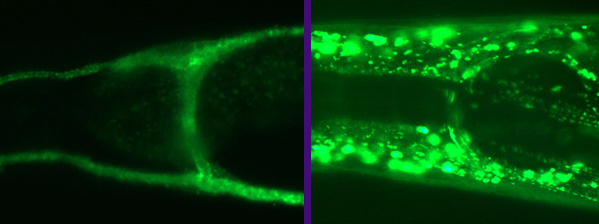

 |
|
A Genetic study of Neuronal Signaling, Glutamate Accumulation, and Stroke-Like Neurodegeneration in C. elegans
Stroke disrupts blood supply to the brain, leading to the degeneration of nerve cells. Stroke and group of associated diseases form a major health-risk throughout our lives, a leading cause of death, and the most important cause of long term disability and hospitalization in the US. Neurodegeneration results from the accumulation and exaggerated action of the brain signaling molecule L-Glutamate (Glu). Glu accumulates in neuronal connections because specialized Glu removal proteins called Glu transporters (GluTs) can not function when brain cells do not have enough energy. The overstimulation of brain cells by Glu triggers a neurodegenerative cascade called excitotoxicity. Currently there is no therapy for excitotoxicity, and our understanding of the process is incomplete. We are interested in the process of Glu accumulation, its prevention, and its consequences. To do that we study the biology of GluTs and the process of Glu-triggered excitotoxicity in the free-living nematode C. elegans, a model system that offers a strong set of research tools. The ability to use sophisticated and elegant genetic analysis tools and the conservation of many cellular processes from worms to humans enabled the successful use of C. elegans research to shed light on many processes in worms and mammals. We use the nematode to study Glu accumulation at three levels: what strategies can be used by GluTs to prevent Glu accumulation, what is the toxic process that results from it, and how can we prevent neurons from dying from this process. We focus on three areas: 
1. Remote Control of Synaptic Activity - The physiology of GluTs: We analyze the regulation of normal synaptic activity by GluTs. We find that nematodes use an unusual strategy of remote uptake to eliminate Glu that has been released into synapses.
We study the molecular events that lead from the pathological accumulation of Glu in neuronal connections to the demise of the affected neurons. We focus on the use of genetics to identify steps where we can block the process of neurodegeneration.
3. Defying the Odds: Cell Stress Resistance, CREB, and Neuroprotection in Excitotoxicity We study the ability of aging-preventing and stress-resistance processes to protect from excitotoxic neurodegeneration.
Our approach highlights the ability of C. elegans studies to provide new insights into strategies of preventing Glu accumulation and identifies decisive events in the processes of neurodegeneration. We hope that our research will provide new inroads to understand the mechanism of critical human diseases. |
Physiol. Pharm. & Neurosci, City College, C. elegans @ CUNY

